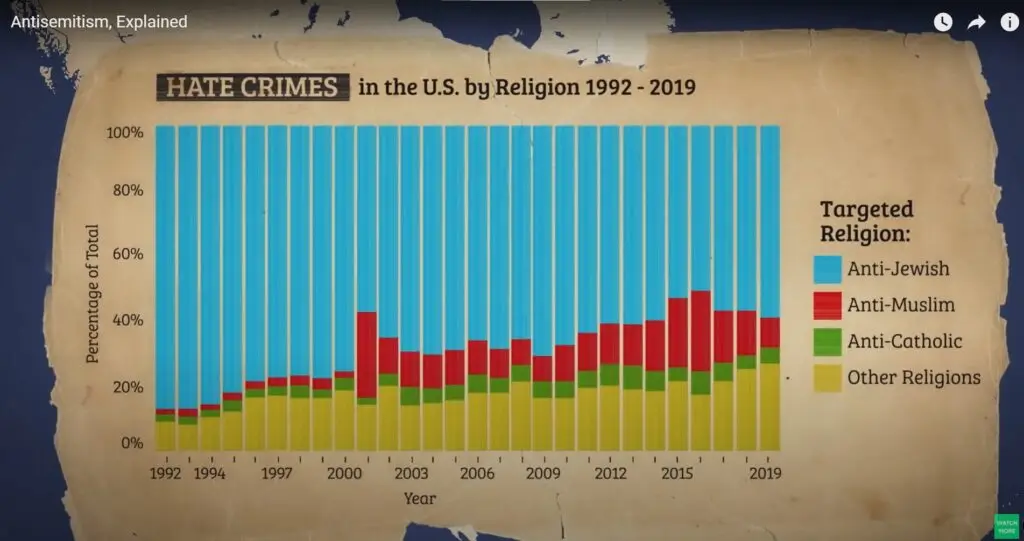The Persistent Problem of Antisemitism (Jewish Racism)
If you asked most Westerners today whether they oppose antisemitism (Jewish Racism), most would likely say yes. Yet, whenever something terrible happens in the world, it seems like it’s only a matter of time before someone blames the Jews for it. This isn’t just about words; it’s about conspiracy theories that have deadly consequences, as massacres of Jews from Pittsburgh to Paris demonstrate.
At lunchtime today, a man armed with machine guns walked into a kosher supermarket and took more than a dozen people hostage. The gunman was killed, but tragically so too were four of the hostages. Far from fading away, anti-Jewish prejudice seems as resilient as ever. So if we agree that antisemitism (Jewish Racism) is bad, why is it still such a big problem? This series aims to answer some of the biggest questions about antisemitism (Jewish Racism), the sort that confuses many people and keeps them from seeing and confronting the hate. We’ll learn together how to effectively tackle antisemitism (Jewish Racism), what it actually is, how to recognize it, and what to do about it.
Antisemitism (Jewish Racism) After the Holocaust
Didn’t antisemitism (Jewish Racism) go away after the Holocaust? Apparently not. Yet a surprising number of people think that anti-Jewish bigotry was stamped out after the horrors of Nazi Germany. After all, didn’t we make a bunch of Holocaust movies and get past this stuff? But while it’s comforting to imagine that antisemitism (Jewish Racism) largely disappeared after World War II, it’s far from accurate.

The Holocaust as Antisemitism’s (Jewish Racism) Culmination
If we make the mistake of reducing antisemitism (Jewish Racism) to the Holocaust, its most extreme manifestation, we’re likely to miss much of the problem today. The Holocaust wasn’t an antisemitic exception; it was antisemitism’s (Jewish Racism) culmination. The systematic murder of six million Jews across Europe didn’t happen in a vacuum. It came after years of religious, scientific, cultural, and political antisemitism (Jewish Racism). For centuries, European Jews were barred from most professions, forcibly converted to other faiths, and subjected to murderous rampages, constant expulsions, and periodic inquisitions. In other words, the mass murder of European Jewry would not have been possible without many centuries of anti-Jewish ideas and assumptions. Take the Holocaust away, and you still have this massive antisemitic foundation underneath. In fact, we are still living with it. Just as slavery’s abolition in America didn’t end racism, the defeat of Nazi Germany didn’t end antisemitism (Jewish Racism).
Highest Religious Hate Crime Group in the U.S.
The statistics bear this out. According to the FBI, American Jews are annually subject to the most hate crimes of any religious group, despite making up only 2% of the U.S. population. Since the FBI began tracking these crimes, more of them have been committed against Jews than all other religious groups combined. Hate crime statistics are an imperfect metric, but they give you a sense of the ugly anti-Jewish undercurrent that has always lurked beneath the surface.

Increasing Antisemitic Terrorist Attacks and Massacres
Recently, more people have started to notice this unsettling reality, as American Jews have been subjected to a series of antisemitic terrorist attacks and massacres. These include the mass shooting at Pittsburgh’s Tree of Life synagogue in October 2018, the April 2019 attack on a synagogue in Poway, California, the shooting at a kosher supermarket in Jersey City, New Jersey in December 2019, and the mass stabbing of religious Jews at their Hanukkah celebration that same month in Monsey, New York. Yet, as bad as this is, the picture is considerably darker in Europe.
European Attitudes Towards Jews
In 2018, CNN surveyed European attitudes toward Jewish people. They found that more than a quarter of Europeans believe that Jews have too much influence in finance. Nearly one in four said that Jews had too much influence in wars and conflicts around the world. One in five Europeans said that Jews had too much influence in the media, and almost the same number said they have too much influence in politics. These conspiracy theories about vast Jewish power are particularly ludicrous when you realize that Jews constitute less than 0.2% of the entire European population. Most Europeans have never even met a Jew.
Fear of Jewish Identification in Public
The consequences of this widespread hostility towards Jews are severe. In 2013 and 2018, researchers at the European Union’s Agency for Fundamental Rights asked Jews about their experiences of antisemitism (Jewish Racism). What they found was alarming. Nearly 40% of European Jews were afraid of publicly identifying as Jewish. Nearly half were worried about being the victim of antisemitic harassment in the next 12 months. One-third feared being the victim of a physical assault. In recent years, Jews have been the victims of brutal antisemitic attacks at schools and synagogues across Europe. It’s easy to understand why so many of Europe’s Jews still live in fear 75 years after the Holocaust, why nearly 40% of them say they’ve considered leaving because they don’t feel safe, and why millions of them already have.
The Holocaust as a Cautionary Tale
Why does this matter to us? Because if we only see and confront antisemitism (Jewish Racism) when it looks like the Holocaust or is committed by obvious actors like neo-Nazis, we’re likely to miss much of it. Society will only notice the problem when it explodes into deadly violence, as in Pittsburgh or Paris, and it’s already too late. Instead, we should understand the Holocaust as a cautionary tale for what happens when more common outgrowths of antisemitism (Jewish Racism) go unchecked, and resolve to beat those back together. As for how to do that, well, first we need to settle the biggest question about antisemitism (Jewish Racism) of all: Whose fault is antisemitism (Jewish Racism)?




